
If you have questions about purchasing a license call 1-800-5GO-HUNT.
The purpose of the MDWFP Wild Hog Program is to inform the public of the risks and concerns brought about by the presence of wild hogs, provide technical assistance to private and public landowners for proper control methods, and to assist in or conduct research to better understand how to control wild hog numbers statewide.
The destructive habits and health risks caused by wild hogs have been a growing concern since their introduction. Wild hogs are a non-native invasive species that have been spreading at an alarming rate throughout the North America. According to a 2010 USDA study, $1.5 billion in damage can be attributed to wild hog activity each year.
Definition of a Wild Hog
According to Admin Code Title 40, Part 2, Rule 7.1, "Wild hogs are hereby defined as any feral hog, wild swine, Russian boar, or any pig that is not a domesticated pet or livestock, or has a wild looking appearance or behavior."
Hunting - Private Lands
License Requirements: Residents: a valid Lifetime, All Game, or Sportsman's License unless otherwise exempt.
Nonresidents: a valid NR All Game Hunting License.
Hunting with archery equipment and/or Primitive Weapons during archery or primitive weapon season: Valid Lifetime, All game, or Sportsman's License and the Archery/Primitive Weapon Permit, unless otherwise exempt.
Other Requirements: Designated agents of the landowner/leaseholder must have written permission from the landowner/leaseholder in his or her possession. A designated agent is anyone who is not the deed holder or leaseholder and has permission by a landowner or leaseholder to hunt or trap on a specific property.
Permission letter must include:
Hunter Orange: Persons hunting wild hogs during any open gun season on deer will be required to wear, in full view, 500 square inches of solid unbroken hunter orange, unless they are hunting from a fully enclosed stand.
Hours/Season: Landowners and leaseholders may hunt nuisance animals year-round at any time of day or night with no weapon/caliber restrictions on property titled in their name or otherwise owned, or leased by them.
Designated agents (persons with permission) of the landowners / leaseholders may hunt nuisance animals year-round at any time of day or night with no weapon / caliber restrictions, provided they have written permission from the landowner or leaseholder in his or her possession, when hunting nuisance animals. Permission letters must be signed and dated by the landowner or leaseholder, and shall include the contact information of the landowner or leaseholder; the contact information of the permitted person; and a specific a date of expiration.
Hunting with Dogs: Wild hogs may not be hunted or pursued with dogs during the open spring turkey hunting season.
Bag Limit: There is no daily or seasonal bag limit for wild hogs in Mississippi.
Hunting - Public Lands
Consult specific regulations on any public lands before hunting wild hogs. Regulations may be more restrictive than private lands. "On public lands, the governmental entity charged with the management of said lands may or may not allow the taking of nuisance animals (wild hogs) subject to applicable laws, rules, or regulations. It is the hunter's responsibility to check with the entity managing the property before hunting nuisance animals (wild hogs) on those lands."
MDWFP Wildlife Management Areas (WMA) Properties: Wild hogs may be taken incidental to hunting activities during any open hunting season with weapons and ammunition legal for that hunting season.
Trapping - Private Lands Only
Legal Wild Hog Trap Definition
"A wild hog live-cage-type trap is described as a permanent or mobile containment system made of any type material capable of confining the mobility of a wild hog unless otherwise removed. The trap must consist of a trap door, slide gate, or similar mechanism. These traps must have at least 50% of the roof open to allow non-targeted deer, turkey, or bear the ability to escape."
License Requirements: Either a valid Lifetime, All game, Sportsman, or Trapping License, unless otherwise exempt.
Trap Operation: All live-cage-type traps must be checked every 36 hours. All non-target wild or domestic animals caught must be removed or released immediately upon detection.
Trap Labeling: Any live-cage-type trap used to trap wild hogs must be tagged or labeled in plain view (written in waterproof ink or stamped) with the owner or user name, address, phone number, and/or MDWFP customer ID#.
Hours/Season: No hourly or seasonal restrictions.
Bag Limit: No bag limit.
Note : Any one who wishes to trap hogs inside a CWD management zone must first obtain a animal control permit.
Use of Bait
Feed/bait may be used to take wild hogs. Any food or food products may be used year-round for the purpose of taking wild hogs with the following exceptions:
Selling of Wild Hog Meat
No meat or other part of a wild hog may be sold without having first been inspected and approved by the U.S. Department of Agriculture and/or the Mississippi Department of Agriculture and Commerce pursuant to the laws, rules, and regulations of those entities.
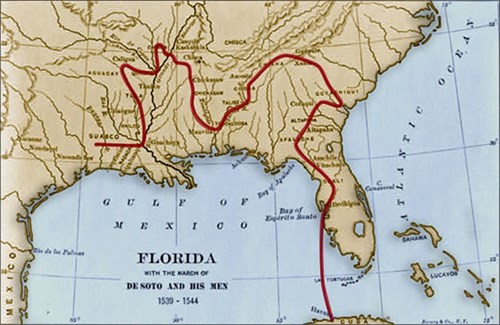
Initial Introduction
Prior to 1539, no swine species were found on the North American continent. Up until then, the only pig-like animal found in the Americas was the peccary (family Tayassuidae). Hernando De Soto, a Spanish explorer, was the first to introduce domestic swine (family Suidae) to the mainland of North America. During his exploration throughout the southeastern United States (red line shown above), he and his men brought along domestic swine from Europe for food. Many of these pigs either escaped from pens or were free-ranged and abandoned. This practice led to the establishment of subpopulations of wild-living swine throughout the Southeast.
The first introduction of swine into Mississippi is thought to be around 1542 in the northeastern region of the state. In January of 1699, Sieur d'Iberville brought more swine to the coastal areas of Mississippi (near Biloxi). As other explorers and colonies began to settle in North America, more and more domestic swine were brought from Europe to the Americas for food. Because of this, most of the subpopulations of wild hogs in our state can be traced back to these introductions of domestic pigs.
Introduction of the Eurasian Boar
Unlike the introduction of the domestic pigs by European explorers and colonies, Eurasian wild boars were introduced for sport hunting. The first North American introduction of the Eurasian wild boar was in Sullivan County, New Hampshire in 1890. The boars (13 individuals) were probably purchased from the Black Forest region of Germany, and introduced into a hunting preserve. Many subsequent introductions followed during the early 1900's. The first known introduction of Eurasian boar in the state of Mississippi was near Port Gibson in 1973.
Today's Wild Hog Population
Due to anthropogenic factors and their reproductive characteristics, wild hogs can now be found in at least 45 states. Currently, there are three variants of what are collectively referred to as "wild hogs" in North America. Present-day subpopulations of wild hogs can be traced back to domestic descent (feralized), Eurasian descent, or a hybrid of the two (feralized crossed with Eurasian wild boar). There are slight differences in morphological and behavioral characteristics between these variants, but no matter what the lineage, they should all be controlled through the same techniques and methods.
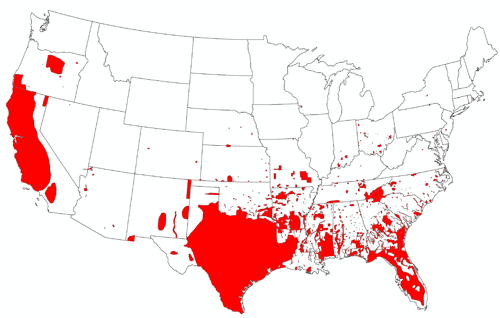
Wild hogs (Sus scrofa), also known as wild pigs, feral pigs, wild boars, feral hogs, feral swine, wild swine, brush hogs, or razorbacks, are now found in at least 45 states and all 82 counties in Mississippi. The most concentrated populations can be found in the southeastern United States and California (shown above). Wild hogs are non-ruminant (simple stomach) ungulates (hoofed mammals).
Their bodies can be described as thick and stocky with short legs and prominent snout. Wild hogs most often have erect ears and short tails which can be curly or straight. Adult males (boars) average 150 to 200 lbs, but can exceed 400 lbs. Females (sows) are usually slightly smaller than boars. The most common coat color of wild hogs is black, but depending on their genetics and lineage, colors such as blonde, red, brown, grey, or spotted or splotchy combinations of these colors may be seen. Young piglets can exhibit black, brown, or tan horizontal striping which fades into solid coloring within about 4 months.
Wild hogs leave a number of tell-tale signs that can be easily recognized by a landowner. Signs left by wild hogs include wallows and rubs, nests, tracks and scat, and rooting and trampling.
Wallows and Rubs
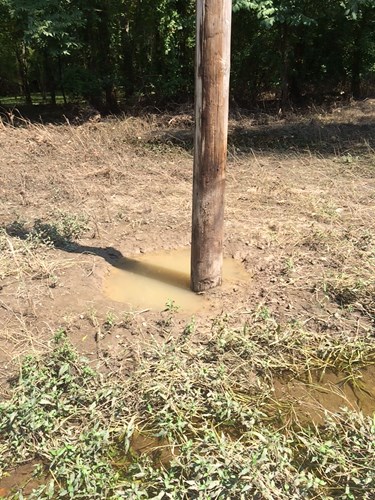
Photo: MDWFP
Since swine do not have functional sweat glands, they create shallow, muddy depressions to coat their skin with mud (above). This aids in thermoregulation and deters biting insects and external parasites. They then rub excess mud off themselves using nearby trees or power line poles.
Nests
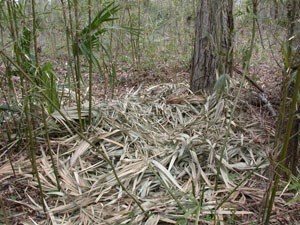
Photo: wildpiginfo.com
A pregnant sow will leave the sounder to farrow (give birth) alone. She constructs a nest of grass and foliage (shown above) for her litter to stay until they can travel with her. These nests can be found in thick vegetation in secluded areas of the property.
Tracks
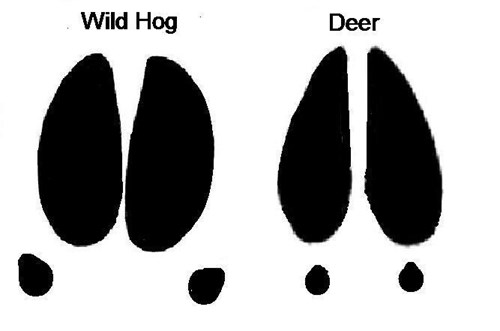
Photo: openroadoutdoors.com
Deer tracks and wild hog tracks can be distinguished most easily by the overall shape of the track and by the tips of the toes. Wild hog tracks appear more round in overall shape than deer tracks (more oval or heart shaped). The tips of the toes of hog tracks are more rounded than deer tracks, which come to an obvious point (shown above). The dew claws of wild hogs are also set wider than deer in proportion to overall track width.
Scat
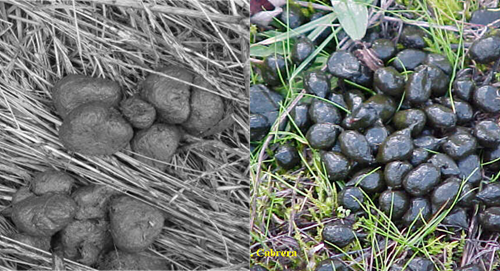
Photo: Chris Jaworoski; bear-tracker.com
Deer scat (right) can usually be distinguished by small, round pelletized pieces, while wild hog scat (left) is usually larger and irregularly shaped.
Rooting and Trampling
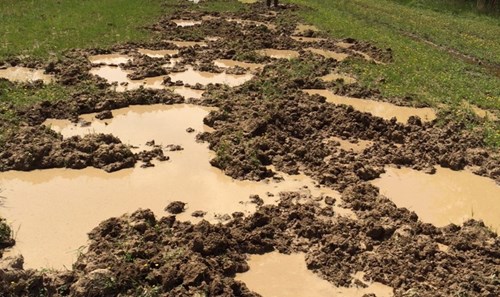
Photo: Clay Gibson
Wild hogs are most noted for their feeding behaviors that include rooting and overturning soil to access food (shown above). This rooting can be several inches to several feet deep. Trampling behavior by wild hogs can also cause crop destruction and habitat loss.
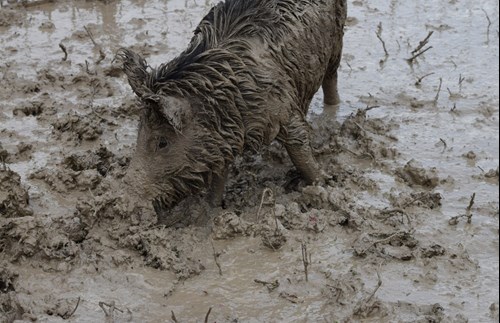
Wild hogs are habitat generalists, meaning they are well adapted to survive in a very wide array of environments. From desert to sub-arctic conditions, these animals can survive and reproduce in almost any habitat on earth. Wild hogs usually prefer areas with easy access to water bodies, especially creeks, rivers, and swamps. Habitat preferences differ within regions of the state and with the time of year. Bedding areas tend to be near water or poorly drained areas with dense vegetation. Since wild hogs do not have functional sweat glands, they create wallows in muddy areas to cool their bodies and deter biting insects.
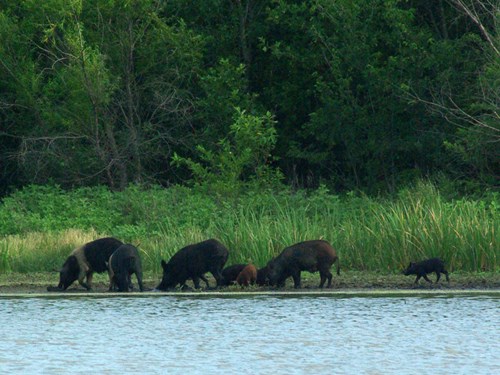
Feeding Habits
The feeding habits of wild hogs are one of the main characteristics that makes them such a problem in the U.S. If food is not readily available above the ground, wild hogs will root up and overturn soil (sometimes several feet deep) to access underground roots, tubers, grubs, seeds, crustaceans, or other food items. The wild hog's diet is comprised of about 90% plant matter and 10% animal matter. This animal matter can consist of reptiles, amphibians, fawns, rodents, worms, insects, or bird eggs.
Concerns for Native Flora and Fauna
During the fall, wild hog diets can overlap white-tailed deer diets by up to 46%, and put undue pressure on almost every other native species of plant and animal. Wild hogs consume 3-5% of their total body weight daily, which can be very detrimental to all wildlife communities. Research has also shown a reduction in desirable plant species in areas heavily pressured by wild hog feeding. Seedling regeneration (natural or commercial) is also diminished in places where wild hogs are prevalent.
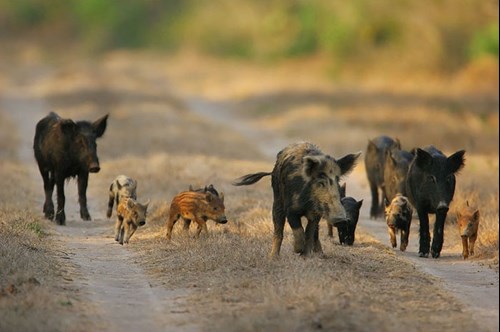
Breeding Behavior
Wild hogs are the most prolific large mammal in North America, which presents many challenges for eradication efforts. An estimated 75% of a population must be removed to maintain the same number of individuals from one year to the next. Most often, wild hogs breed once or twice per year in favorable conditions. Compared to other large mammals, wild hogs have a very short gestation period of about 114 days. Sows are sexually mature at 6-8 months of age and average 4-6 piglets per litter.
Social Behavior
Wild hogs can be found in social units called sounders. These sounders usually include one or several mature sows with one or more generation of offspring. A sounder can be comprised of a few individuals to several dozen. Sub-adult males will disperse from the sounder at approximately 16 months of age, while females may stay with the sounder or leave to found their own at about one year of age. Newly dispersed boars can often be found in small social units called bachelor groups. By the time boars reach full maturity, they are usually completely solitary, only interacting with sounders to breed.
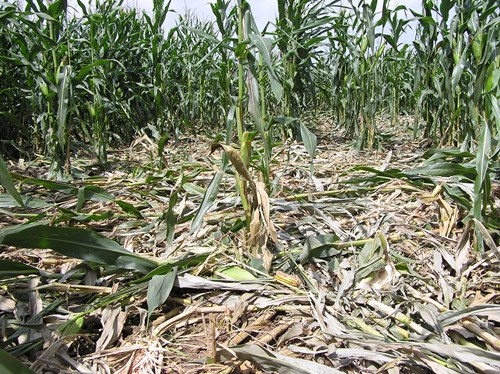
Economic
According to a USDA study, wild hogs can be blamed for $1.5 billion in damages every year in the United States. The feeding habits of wild hogs make them particularly destructive to crops, woodland habitats, levees, moist soil units, golf courses, and right of ways. Wild hogs can cause massive losses for farmers during planting and before harvesting by trampling or eating crops or rooting up and eating seeds before they can sprout. Destruction of seedlings by wild hogs during forest regeneration operations can also be an economic detriment in many areas.
Native Species
Wild hogs also cause damage to native flora and fauna as well as the habitats in which they reside. Whether by direct predation of small mammals, amphibians, reptiles, eggs, and insects, or by competing with animals such as white-tailed deer for valuable resources, wild hogs create a stress on almost all native wildlife species. The disturbances caused to the soil due to rooting behavior can cause invasive plant species such as Chinese tallow to become more prevalent.
Other Concerns
Many of the places where hogs are now found are home to threatened or endangered species. Many species such as wading and shorebirds, many amphibians, alligators, and even sea turtles are suffering a decline in reproductive success or population declines due to the predation of wild hogs.
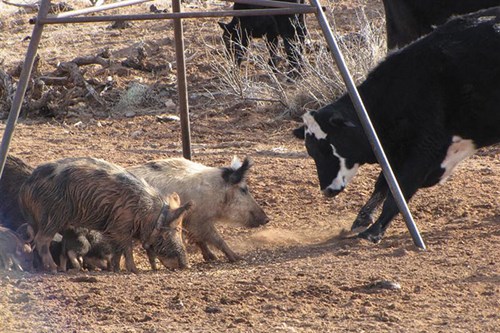
Wild hogs are capable of transmitting at least 30 virulent and bacterial diseases and at least 37 parasites. Many of these can be transmitted to livestock, pets, wildlife, and even humans. Diseases such as Brucellosis, Leptospirosis, and Pseudorabies can threaten the populations of native species, livestock production, or human health. Another concern of wild hog disease, especially within the livestock industry, are foreign animal diseases (FADs). These diseases such as Classical Swine Fever, Foot-and-Mouth Disease, or Bovine Tuberculosis could be catastrophic if introduced or re-introduced to domestic livestock production. For example, an outbreak of Foot-and-Mouth Disease is projected to cost the livestock industry $14-20 million if it occurred in the U.S. today.
Wild hogs also reduce water quality by increasing turbidity, which can change the composition of native plant and animal species. They also introduce large amounts of coliform bacteria (E. coli), which can be spread to other wildlife, livestock, and humans.
How to Minimize Disease Risk
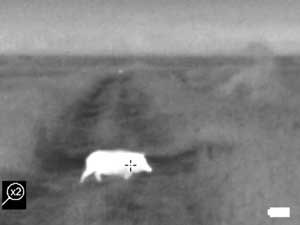
In the state of Mississippi, nuisance species (including wild hogs) may be taken by landowners or lease holders 'year-round at any time of day or night with no weapon / caliber restriction on private lands. However, if you are hunting at night, it is strongly recommended to contact your local sheriff's department to inform them of your plans to discharge a firearm during nighttime hours. Also, be sure you are familiar with the layout of the land you plan to hunt (i.e. locations of residential areas, highways, etc.) and carefully review all regulations regarding the take of wild hogs in Mississippi. Finally, be sure of your target. Accidentally shooting non-target species (such as deer or bear) carry serious consequences, so be sure you know what you are shooting at before pulling the trigger.
Overall, the shooting of wild hogs is not as effective at controlling wild hog numbers as trapping. However, it can be useful for removing mature individuals that have become "trap shy." If you are shooting wild hogs on your land, be sure to target mature sows when possible, as they contribute more than boars to populations growth.
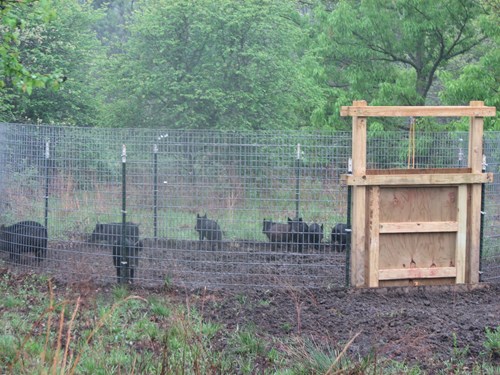
The best method of controlling wild hog populations is trapping. There are dozens of different trap sizes, designs, door types, and trigger types to choose from. Studies have shown that larger diameter traps and wider doors will yield much better results than their smaller counterparts. Many types of bait can be used including sweet potatoes, dried or fermented corn, over-ripened fruits and vegetables, or commercial attractants.
It is important to remember that the key to population reduction is the removal of entire social groups (sounders). Catching whole sounders in large corral traps is a much more efficient means of control because all individuals (up to 20 or 30) can be removed in a single catch, rather than removing a few at a time with smaller box or cage traps.
Note: All who wish to trap wild hogs inside the CWD Management Zones must obtain an Animal Control Permit
More About Trapping Wild Hogs
There has been lots of talk in recent years about the use of toxicants for wild hog control efforts. Several toxicants have been used in Australia such as sodium nitrite, yellow phosphorous, and compound 1080 (sodium flouroacetate), but none of these toxicants have been approved for use in the United States.
Ongoing research is being performed by various state, federal, and private agencies to devise a way to safely and selectively administer this toxin to wild-living swine populations, but there are no lawful means of wild hog control with the use of any type of toxicant or poison at this time. Remember, it is illegal to distribute any type of toxin, poison, or other harmful substance on your land for the use of wild hog control.
A: Wild hogs are the most prolific large mammal in North America. Once wild hogs are established in an area, they can spread rapidly and reproduce twice per year. They can be blamed for at least $1.5 billion in damages in the U.S. every year. This damage includes agricultural damage, levees, food plots, golf courses, water quality degradation, wildlife population declines, and damage to sensitive habitats such as wetlands and beaches. Wild hogs can also spread a myriad of diseases to livestock, pets, wildlife, and even humans.
A: The best option to take care of the problem yourself is to build or buy traps for your land. In general, one trap per 1,000 acres of land is usually adequate for control. There is a wealth of resources online through MDWFP, USDA, MSU Extension, and many other sites. If you decide to pay a private individual to remove wild hogs from your property, make sure the individual is dispatching all wild hogs on site before leaving your property.
A: Anything. They are classified as opportunistic omnivores, which means they will eat just about anything they come across. Most of their diet (about 90%) consists of plant matter, but they also will not hesitate to eat live or dead animal matter including fawns, reptiles and amphibians, birds and bird eggs, small rodents, insects, and crustaceans.
A: Sows as young as 6 months or even younger have been recorded as being able to breed. They average 4 - 6 piglets per litter, but can have as many as 12. Gestation for wild hogs is about 114 days, which means females can breed two times per year in ideal habitat.
A: Wild hogs are leaner and more agile than domestic hogs with longer legs and snouts. Wild hogs appear more hairy than domestic hogs as well. Sometimes, domestic hogs have curly tails and flopped ears, while wild hogs have straight tails and erect ears, but this depends on the breed of domestic hog or the ancestry of the wild hog. In general, domestic hogs will have solid-colored hair shafts, while wild hogs may have a grizzled (multi-colored) appearance. The skull of a wild hog usually slopes gradually to the top, while domestic hogs have a steeper incline toward the top of the skull.
A: Yes, however, it is important to make sure you take appropriate precautions while dressing and cooking the animal. Wear protective gloves while dressing and butchering the animal, and properly disinfect all utensils and surfaces that have been exposed, and make sure the meat reaches pasteurization temperature (165° F).
A: From the last day of turkey season until the first day of deer archery season, it is legal to hunt wild hogs over bait with no distance restriction on private lands. However, the feed must be in a covered, above-ground container and cannot be placed directly on the ground. Corn or other bait can only be poured or placed directly on the ground inside a legally designed wild hog live-catch style trap. Anyone who wishes to trap hogs inside a CWD management zone must first obtain an animal control permit.
A: Yes. Hunting wild hogs requires a valid Lifetime, All Game, Sportsman's license unless otherwise exempt. Trapping wild hogs requires a valid Lifetime, All Game, Sportsman's, or Trapping license, unless otherwise exempt.
In addition, persons hunting wild hogs with archery equipment or primitive weapons during archery or primitive weapon season must possess either a valid Lifetime, Sportsman's License, or an All Game Hunting License AND the Archery/Primitive Weapon Permit, unless otherwise exempt.
Non residents must possess a valid NR All Game Hunting License or a NR-7-day All Game Hunting License.
A: No!
A: No, it is not legal to use any type of toxicant or poison for wild hog control in the United States.
A: Trapping. Large corral traps are the most effective option for eliminating entire sounders (social units).
A: Wild hogs leave a variety of tell-tale signs that a landowner can easily recognize. Since hogs have no functional sweat glands, they wallow in the mud to cool off and deter biting insects. The "wallows" made from this activity will appear as a mud or water-filled depression in the ground. Wild hogs then rub excess mud off of their sides against trees or powerline poles. Probably the most notable sign that you have wild hogs is rooting. Wild hogs root under the surface of the ground to access food buried in the soil. This rooting will be strips or large patches of overturned soil that can be inches to several feet deep. This rooting can occur in food plots, agriculture fields (especially underground produce), forest floors, edges of water bodies, or levees.
A: On private lands, wild hogs can be taken year-round with no weapons/caliber restriction at any time of the day or night. However, if you choose to hunt wild hogs at night, be sure to take these precautions:
A: Absolutely! There are at least 30 virulent and bacterial diseases and about 37 parasites carried by wild hogs. Many of these diseases and parasites can be transmitted to humans through infected water, bodily fluids, and ingestion of the meat, so always handle wild hogs with the following safety precautions.